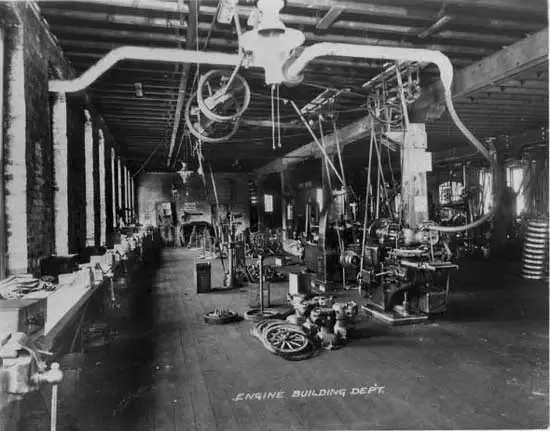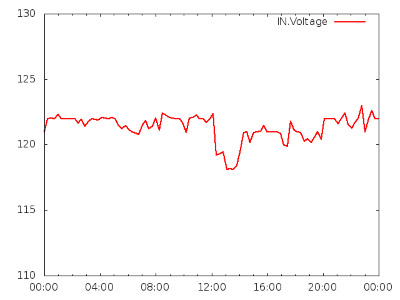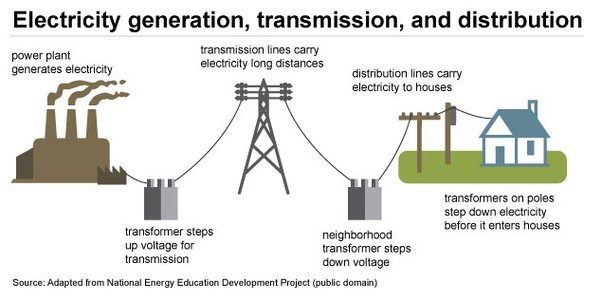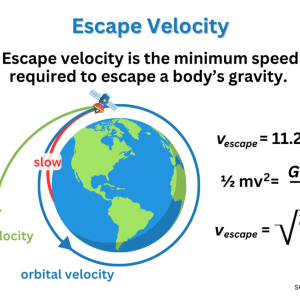First of all, the electricity you use in your house doesn’t “Come from a power station”.
It comes from a transformer located maybe 300 feet from your house. Either up on a pole, or sitting on a pad.
The power that transformer gets doesn’t come from a power station either.
It comes from a substation.
And maybe that substation gets it from a power station, and maybe not. It MIGHT get it from a larger substation miles and miles away that gets it from the power station.
The voltage you use in your house is MUCH too small to be useful for travelling long distances.
To send a standard 120/240-volt power supply several miles, you’ have to have an insanely large conductor and shove an insanely large amperage through it to overcome conductor resistance.
So power companies get around this by cranking up the voltages to insane levels.
The higher the voltage, the lower the amperage needed.
Double the voltage, cut the amperage in half. Which also reduces the conductor size required.
Electricity is generated at the power plant, then the voltage is cranked way up for long-distance transmission, using special high-voltage transformers. And that’s as far as the electricity generated at the power plant goes. It goes from the generator, to buck/boost transformers at the transmission station, and back to the power plant.
The electricity in the transformers from the power plant induces an electrical current on the other side of the transformer, and is sent out on the transmission lines.
Near the customer, it goes to a substation where the voltage is decreased to a manageable level, usually arounds 13,000 volts.
Once again, the high-voltage transmission current does not go past the local substation transformers. it induces and electric current, that travels through distribution lines to the transformer near your house.
The 13,000 volts on the “High-voltage” side of the transformer near your house induces a voltage on the low voltage side of 120/240 volts.
And that’s what goes to your house. It just makes a loop from the transformer to your house, and back to the transformer.
The additional load on your transformer when you turn on a light is so negligible, a meter put on the high-voltage side of the transformer would not be able to measure that added load.
It might put an additional 1/100th of an amp load on the transformer.
A whole city turning lights and stoves and TV’s on at night DOES put a significant additional load on the grid.
But power companies know this, and put additional generators online in anticipation of this additional load.
Let me offer an answer using not electricity, but mechanical power as an analog.
But first… have you ever wondered why the almost universal depiction of a stereotypical factory inevitably comes with a smokestack?

When you actually look at a modern factory, it usually has no smokestacks at all. Rather, it is probably just a nondescript warehouse-style building in an industrial park somewhere, indistinguishable from similar buildings that are used as actual warehouses, strip malls, etc. But that’s because in a modern factory, most machinery would be powered by electricity. This wasn’t the case in the 19th century, however. In fact, the typical interior of a factory was like this:

See all those gears and belts and whatnot just under the roof? That’s what powered the machinery. Every factory had its own stationary steam engine (hence the smokestack!) that produced a fair amount of mechanical power, which was transmitted mechanically to the factory floor through gears and shafts. Individual pieces of machinery were connected to shafts under the roof using belts or other mechanisms. Machines were connected or disconnected with clutches, when needed. The steam engine, which might have been housed in its own building actually, powered the shafts at a constant rate of rotation.
Now what happened when you attached a new piece of machinery to the shaft, drawing more power? Obviously, it would slow the shaft down. But the steam engine had a regulator (governor), a mechanical contrivance that sensed when the engine was slowing down or speeding up and responded by increasing or decreasing the flow of steam, opening or closing a valve. So while there would be a brief, transient slowdown in the shaft’s rate of rotation, the regulator would quickly kick in, and through an increase in the flow of steam, restore the nominal rate of rotation. Conversely, if a machine was disconnected from the shaft, there would be excess power and the shaft’s rate of rotation would increase; the regulator would sense this and close the steam valve, reducing power to the steam engine, again restoring the nominal rate of rotation.
Electrical power networks work pretty much the same way. In fact, if the generator happens to be driven by steam, its feedback mechanism may be recognizable to a 19th century engineer! When you turn on a load and increase the power draw on the generator, the generator would start the slow down. As soon as that happens, its governor (be it mechanical, electrical or electronic/computerized) kicks in, increasing its power (e.g., by opening a steam valve if it is a steam turbine) and restoring its nominal rate of rotation, so that electric power continues to be generated at the correct voltage and frequency.
Of course it also helps that modern electricity networks tend to be gigantic (often serving a large part of a continent), so any individual load, even if it is something a lot larger than a light in your room, is dwarfed in comparison.
Moreover, there is plenty of tolerance. The line voltage does not need to be maintained exactly. In fact, while the frequency is supposed to remain stable, significant variations in voltage are permitted by electric utilities. For instance, here is what my server’s UPS (uninterruptible power supply) measured the day before yesterday throughout a 24-hour period:

One can only guess what happened, e.g., around noon when there was a noticeable drop in voltage. Did a major power station go offline here in Eastern Ontario, Canada? Or did a large consumer such as a major data center or manufacturing facility suddenly come online? Or was it just a local event, something that increased the load on the large transformer nearby that serves my neighborhood, reducing its output voltage a little? Whatever the reason, every change in the voltage that you see in this plot is a result of some event of this nature: either a power source or a load getting connected to, or disconnected from, the system.
What these variations in voltage do is quite simple. Suppose your electricity network is generating 100 megawatts and exactly 100 megawatts is being consumed. But now, you turn on a 100 watt light. That would mean 100.0001 megawatts, but that much power is not available. Instead, the voltage drops a little. As a result, all the loads that previously received 100 megawatts of power now receive only 99.9999 megawatts; an almost imperceptible 0.0001% drop. Meanwhile, your light comes on and consumes not 100 watts, because the voltage is slightly lower, but only 99.9999 watts. Again, an imperceptible difference. But when you add the two numbers, you notice that the total system consumption remains 100 megawatts, like before, and the balance between power generated and power consumed remains in place.
Well, this is an interesting question.
So we have an individul user, as they turn on a light in their home.
Lets assume it is a 100W load that is presented to the bussbar of the main home distribution panel.
The nominal voltage at the panel is 120 Volts on each of two half phases, split with a centre tap neutral in N. America.
The resistive load for the instant that the incandescent light bulb presents is close to 10 amperes, but then declines to a nominal 1 ampere (approximately).
The 10 ampere load is observed by others on the same pole transformer as a flicker, The instantaneous voltage takes a drop, and appears as a voltage sag, but only for less than a tenth of a milisecond.
However, this is not about the current surge when the lightbulb is turned on. This question is about the 1 ampere current, and how is that felt, through the network, ending at the power station of 800–1000 MW.
Essentially the network, only has a small regulator attached to the steam valve, that continually monitors the load presented at the generating station, so that the loop is in constant feedback, within prescribed limits, and the wires between the various substations act as resistors, that absorb some of the voltage fluctuations.
The outside transformer at the pole transforms the nominal 12kV down to the secondary voltage of 240 volts with a 50:1 transformer.
This also means the current of 1 ampere is also transformed on the line into a 2 mA ( milli-amperes) load in addition to the existing load on that particular substation branch circuit.
What happens at the substation?
The similar substation impact is felt, but absorbed through the resistance of the substation 2 miles away.
Only, instead of it being 2 mA, it is reduced by the amount of current, that is now being supplied by that substation at its secondary.
While the 2 ma output is next to impossible to adjust for, since there is a known resistance already present in the lines to the pole transformer. The nominal 12kV is droppped by 1/100 of a volt, by the action of that one light bulb in the substation’s power summation point.
Can the substation ‘absorb’ 1/100 volt of fluctuation?
From 12,000 to 11,999.99 the voltage drops. on the secondary side of the substation.
- Barely a drop in the bucket.
The same phenomenon happens on the primary side of the substation, where the power is coming in at 600kV, and through a transformer, is voltage transformed to 12kV. This is accomplished by a 50:1 power transformer.
On the secondary side , the current went up by 2 mA.
But on the primary, the current changed by a corresponding one 25th of a milli-ampere due to the substation’s 50:1 power turns ratio.
The bus bar from the substation, then will have an impact of how much?
1 micro ampere!
The generating plant is typically within 100 miles of the major load centre. In between are the resistive losses of the wires between the sub-transformer, and the feeder lines, along with the miles of cable strung on the outside pylons.
Lets assume it is 100 miles of cable.
At the remote sub-station end, is the nominal 600kV feeder, and now is presnted an additional 25 micro ampere of load , and yes, the load is felt instantaneously by the transformer that is at the other end, where the voltage is stepped up, from 6 kV to 600 kV, and the prime mover from the generating plant gets impacted, not by the additional mili-ampere, but because it is transformed by the power station trnsformer (at a ratio of 100:1, it is micro-amps at the secondary side, or 250 mili amps on the primary.
The 250 mili ampere is not going to be felt in the prime mover, since the rotational velocity (its a 60 Hz generator) keeps the machine rolling at 1800 RPMs.
This is where that tiny amount of power surge ends at.
There is no detectable impact at the rotating machine of a variation that small.
So, where does the energy come from? The line was alredy a little bit ‘warm’ when the switch for the lightbilb was thrown, and this one bulb,just increased the current felt at the plant’s tansformer by 25 mili-ampere.
But suppose 1,000 people did this all at the same time?
Now you have a sgnificant load change. (Actully ,not much)
How about 10,000? Well, that would be 250 mA or a quarter of an Ampere from a system that is pumping out 100 Amperes at 600 kV.
Still a drop in the bucket.
What happens then?
Then the frequency of the line starts to begin to drop from 60 Hz and 1800 RPM down to 1799, then 1798 dropping to 1795…..
[This is the same thing what happened, in November 1965 with the Northeast blackout of 1965 – Wikipedia , where the nominal 60 Hz line frequency dripped to 51 Hz, but this is the extreme]
That then makes the regulator on the steam plant open up the valves for more steam to be admitted to the turbine.
The additional power then pushes against the turbine ,and the RPMs go back up to 1796 then 1797 then 1798 finally ending at 1802. when the steam valves are no longer opened up any furthur.
This can take a minute or two to stabilize, and then the turbine settles down to the nominal 1800 RPM.
This is how the operators adjust for the respective load changing all the time ,as each switch in the network is turned on, then off.
But what happens when the light bulb is turned off again 2 minutes later?
Then the whole process in reverse happens, and the voltages drift upward, and the current gets reduced. the Steam valves get closed, and the RPM of the generator start to go up, and the system then regulates the amount of steam admitted to the turbine, and the process continues. The valve is closed slightly, and the RPM reduce from 1805 to 1800 (nominal).
However,
I heard someone say on a radio show that it’s done by using flywheels to store a reserve of power; is that true?
There is no such thing as a “flywheel reserve*”, that is utter nonsense.
There are water storage reservoirs, but that is different.
What actually is happening, is the turbine is connected to the large generator shaft, and this is where the “turbine flywheel” actually has any change in the angular momentum at that very moment. It shows up as the loss in rotational velocity, or RPM ,as the load goes up, and as the load goes down the RPM go up.
If this “radio show” is authoritative, then where are these “flywheel reserves” kept? .
Here is a simplified diagram of how it is strung together.

** Edit 1: There are balancing machines, that use flywheels as their moments of Inertia maintainers. These machines convert electrical energy and convert some of that motion back into electric energy, but they are only able to sustain a brief interruption. Eventually, the mass loses its velocity, and the load begins to slow down.






